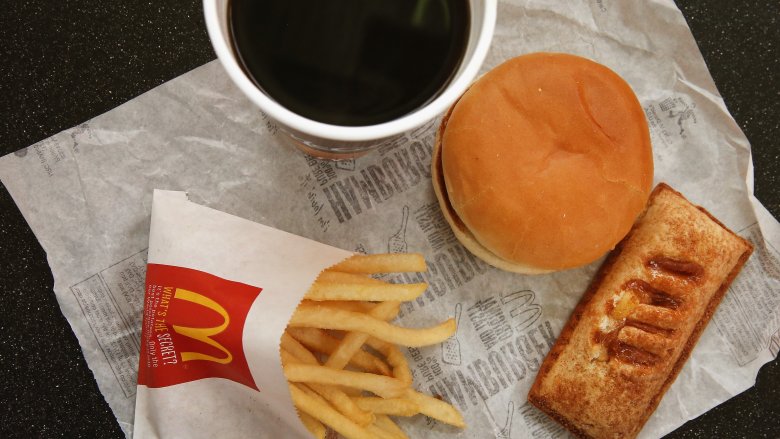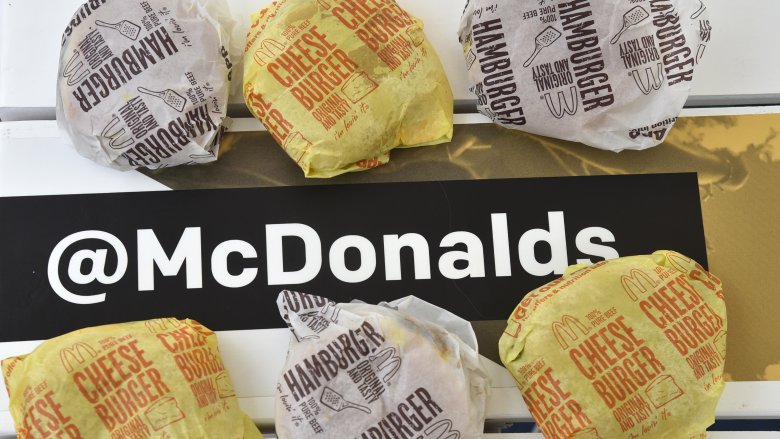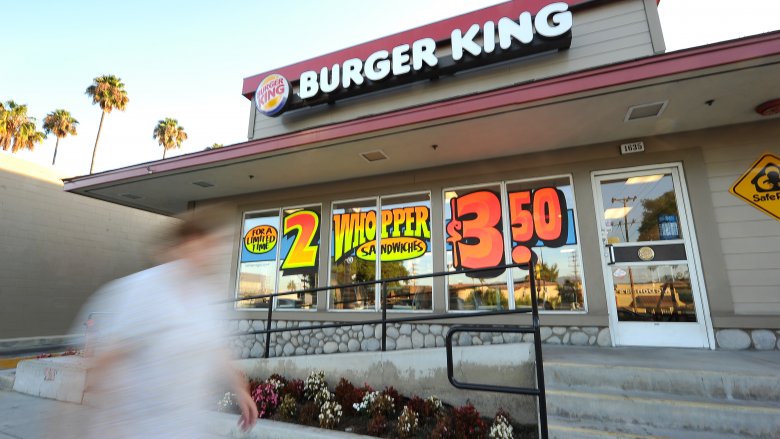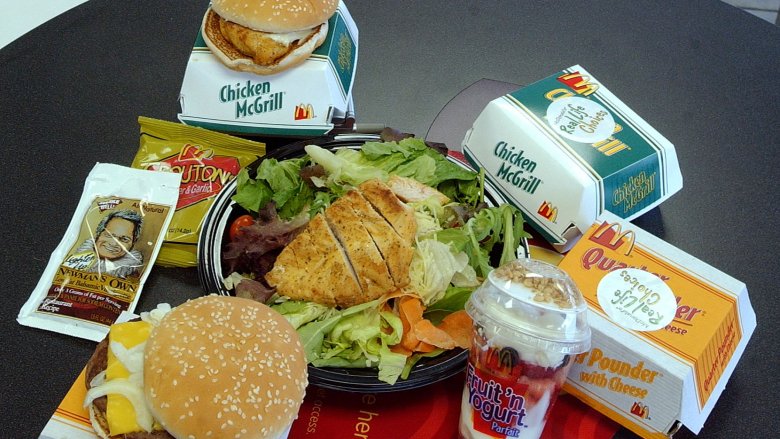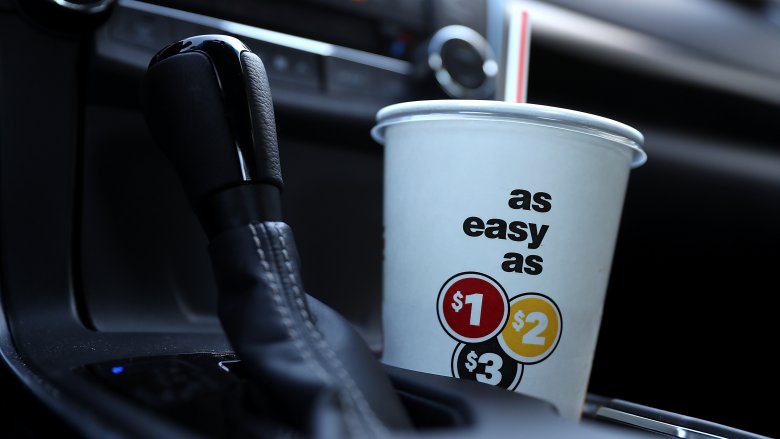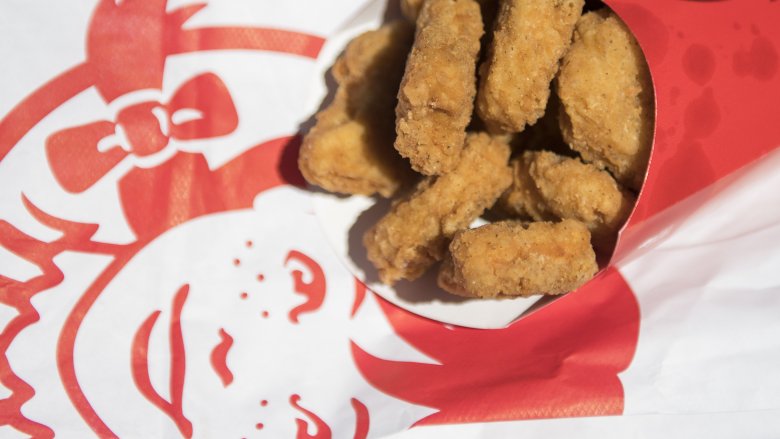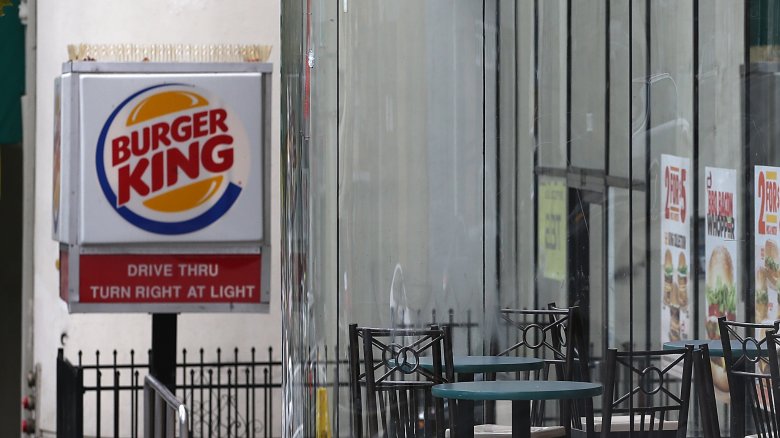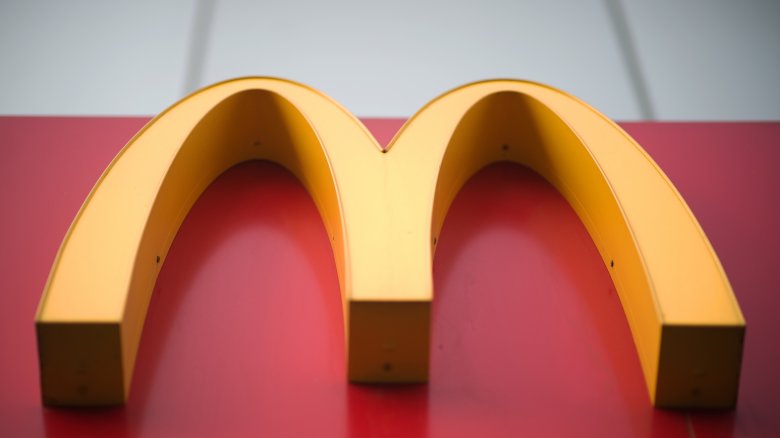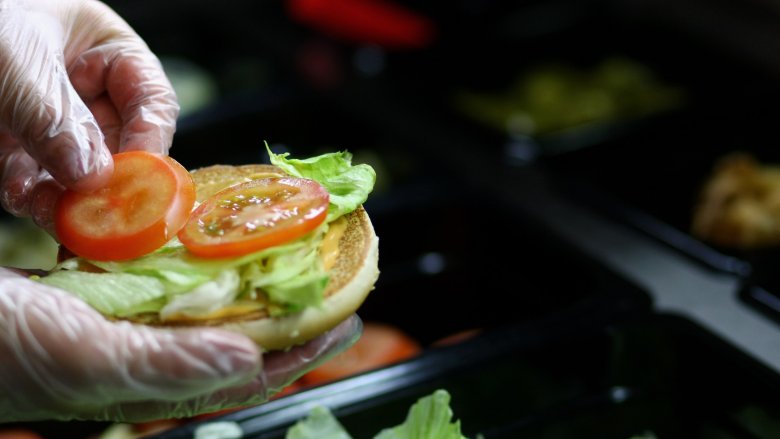Why Dollar Menus Are Disappearing Across The Country
Whether you're grabbing a quick snack and only have the change in your car handy or you're needing to feed an entire junior high football team, a dollar menu can be a lifesaver. It's not just affordable, but it's usually a hot treat that's more delicious than you really want to admit, and it satisfies a craving for an occasional — or frequent — guilty pleasure. The menu items are usually just the right amount for when you're not too hungry but know you need to get something to eat, and when you're on the road, it's perfect.
It seems like it would be a win-win, great for customers and great for fast food places, too. It gets people in the door, and that's what they want, right? But almost indiscriminately across the fast food landscape of America, dollar menus are disappearing.
Why? It's actually a complicated combination of a lot of things, and some are very surprising.
Beef prices and inflation
In 2013, McDonald's announced (via The Atlantic) they were going to completely get rid of their Dollar Menu. Even that ended up being more complicated than it seemed at first glance, and it turned out to be not so much a disappearance as a reboot.
At the heart of the problem was money. According to QSR, McDonald's released their Dollar Menu in 2003. Continued competition between fast food chains kept prices low as everyone scrambled for their piece of the pie, but a decade after launch, those Dollar Menu prices became problematic.
Over the years, the cost of ingredients has been steadily on the rise. Prices franchisees pay for ingredients have fluctuated, but the Dollar Menu? That's stayed the same low, low price, and that's a huge problem.
Just look at the cost of buying beef. According to the Official Data Foundation, the price of uncooked beef was 69 percent higher in 2013 than it was in 2002. That's an average increase of more than 4 percent each year, and as you might imagine, the profit margin on cheaply priced menu items just isn't wide enough to weather that sort of increase.
The Burger King lawsuit
In 2009, the ketchup hit the fan when Burger King franchisees banded together to protest corporate's long-term 99-cent double cheeseburger promotion. The reason for the outrage was pretty simple: each one of those double cheeseburgers cost them about $1.10 to make.
According to Business Insider, franchisees originally rejected corporate's push to sell the super-cheap burgers, and the conflict eventually led to a lawsuit on behalf of the franchisees. Burger King said it had a right to force franchisees to participate in promotions, while franchisees said it wasn't right for them to try to force them to sell a product at a loss. Some stores — like a family-owned New York City franchise run by Elizabeth and Luan Sadik — had already closed in the past because low-priced items dug too far into their profits. Franchisees were fighting to keep it from happening again.
In 2011, Reuters reported that corporate and their franchisees had settled. In exchange for dropping the lawsuit, franchisees were given more control over pricing, promotions, and ultimately, the Value Menu. No one can possibly expect any restaurant to sell their product at a loss — especially when they're paying royalties to their parent company on every burger sold.
Millennials aren't buying it
Fast food restaurants are caught in a sort of Catch-22. On one hand, they need to be cheap enough to appeal to a customer base that's looking for a super-cheap meal, but on the other hand, that same super-cheap meal isn't going over well with an entire demographic: millennials and Generation Z.
According to the BBC, people under the age of 40 aren't just shying away from dollar menu prices, but most fast food in general. They're willing to spend more money on their lunches — as long as they're getting sustainable, high-end ingredients.
Overwhelmingly, millennials have said that for them to eat at fast food places like McDonald's, the food would have to be of higher quality, more nutritious, and served without any artificial ingredients — something that's pretty hard to achieve on a $1 item without losing a lot of money. Better ingredients cost more money, after all.
The menus were getting too crowded
People don't just want fresher ingredients, they want healthier ingredients too, and according to Forbes, fast food chains are responding.
In 2016, McDonald's was looking at not just the cost of doing business with these new demands, but the cost that was going to get passed on to their customers. The old saying that you get what you pay for is true, and since customers were leaning more toward salads, wraps, and whole grains — which are all a lot more expensive to make — they debuted on the menu with prices much higher than $1.
And that, in turn, leads to a balancing act. Adding more healthy menu items means reevaluating an entire menu, because you can't just keep adding things to a menu without dropping others. The Balance Small Business warns that one of the key components of any restaurant is having a menu that's a manageable size: it cuts down on waste, chaos in the kitchen, and customer confusion. And, when it comes to keeping a menu balanced with healthy, high-end stuff on one end, guess what else has to be cut? The cheap stuff that's just not making them any money.
Not as many people order off of the Dollar Menu as you'd think
It goes without saying that any restaurant is going to want to keep the items that most people are looking for, the items that are making them the most money, and the items that are getting people through the doors. When it comes to popularity, there aren't as many people ordering off dollar menus as you might expect.
Take McDonald's, for example. In 2013 — when they were still focused on making their Dollar Menu bigger, badder, and more successful — the Chicago Tribune found (via Business Insider) that a shockingly low portion of their business actually came via the most affordable section of their menu.
Only between 13 and 15 percent of their sales came from the Dollar Menu, and that's almost unbelievably low. It's about the same for other chains, too, and industry analysts say those customers are also a portion of the consumer base they just can't afford to lose. After all, 15 percent of sales doesn't sound like a lot, until you're talking about losing it.
Customers say that even though they might like other restaurants and foods better, McDonald's kept them coming back with value. So... how do they have the best of worlds?
Tiered "dollar" menus were rolled out instead
It wasn't until 2017 that McDonald's officially announced they were coming out with a replacement for their Dollar Menu. The announcement was met with all kinds of optimism, with Business Insider saying it had the potential to be "the biggest fast-food news in years." They said that by early 2018, budget-minded customers were going to once again have some bargain choices, all menu items priced at $1, $2, and $3. This seems like a win-win — chains could still offer a few menu items at low price points, without going so low they end up losing out.
Fast forward to the end of 2018, though, and Business Insider was no longer impressed. The tiered menu hadn't been nearly as successful as McDonald's had hoped, and they went back to the drawing board to come with with things like Mix-n-Match deals, options that would avoid the pitfalls they'd discovered with their tiered system.
Analysts say that not only is McDonald's too focused on their Dollar Menu offerings, but that the tiered system encourages the most budget-minded customers — those they're targeting the most — to opt for the lowest costing foods instead of the higher-priced options. It didn't help when they removed the best deal on the menu — the $3 Happy Meal — and left customers with kids looking elsewhere for a bargain.
Sonic and Wendy's are doing it differently
When it comes to value, Wendy's and Sonic have two very different ways of doing things.
According to QSR, Wendy's was actually the first to promote the idea of a dollar menu, way back in 1989. But they did it a little differently, and that's allowed them to weather change a little better than McDonald's and Burger King. While those two chains took established menu items — like the double cheeseburger — and lowered the price, Wendy's created their 99-cent menu from scratch. They developed items they could sell at that price point, and made sure customers could pick and choose to order a whole meal off the value menu. It worked. Today, they no longer have a 99-cent menu, but they do have a Value Menu that's full of items designed to sell at very low price points (which, for many locations, is still under $2).
And according to the Wall Street Journal, Sonic veered even farther away from the value menu. At the same time McDonald's was ditching the Dollar Menu, Sonic was being "more strategic" about keeping prices affordable while still being low enough across the board to keep people coming back. Analysts were dubious about keeping out of the dollar menu game, but Sonic doubled down when it came to not even having a value menu in the works, preferring to add "premium" items instead.
They're not great at getting new customers in the door
There are two types of customers: the ones you have, and the ones you're trying to get. That said, there's an important question restaurant chains have to ask: Does having a value menu or dollar menu lure customers away from chains that don't?
In 2018, the market research firm NPD Group ran a study to try to determine whether or not new customers were attracted to a certain place by their dollar menu offerings, and the short answer is: No. They did find that while an overwhelming majority of customers who bought something off the value menu purchased it as an add-on to a regular menu item, there was no increase in the numbers of new customers linked to value menu promotions.
Warren Solocheck, the president of their foodservice division, said (via Skift Table) that it was a surprising result. While it would seem logical that people might be more inclined to try a new place when there was minimal financial risk, the numbers just didn't reflect that.
It's associated with a brand problem
Image is everything, and as of about 2017, McDonald's was starting to find their super-affordable image wasn't doing them any favors in a changing world. According to QSR, there's something pretty straightforward at the heart of McDonald's struggling sales: they're known for cheap, hot food at a time when people just want more, and the Dollar Menu hadn't helped.
Motley Fool analyst Jason Moser put it this way: "...I really don't know that there is anything McDonald's can do. I think part of their problem is, even if they're able to up their game on the quality side, I think there is a brand problem at this point."
In order to overhaul their image, McDonald's is reimaging favorites and investing in mobile technology and ordering kiosks. They're also trying to shed their "cheap" image a bit, and that means shutting the door on the Dollar Menu.
Similarly, Jack in the Box's recent value menu was a failure — likely because their established customer base isn't going there for value, but for quality. According to analysts, offering food much cheaper than customers are used to may have actually hurt their brand more than helping it.
The theory behind why bargain menus are still a thing
The world of the dollar menu was built on this: get people in the door with value, entice them to buy more, and make both money and long-term, repeat customers. But in today's changing landscape, it's just not working anymore — and that's true whether you're looking at customers who value quality over quantity, or bargain-minded diners. Everything changes, and that includes dollar menus.
According to Patricia Smith of the University of Michigan (via the BBC), the only way dollar menus are profitable is if they're selling those items in massive quantities. They're looking for customers who are going to order a full meal off the value board, then tack on a $1 dessert at the end — and they're hoping a few people in line behind them do the same. As long as that keeps happening, value menus will probably stick around in some form or another, they just might not look like you're used to.
